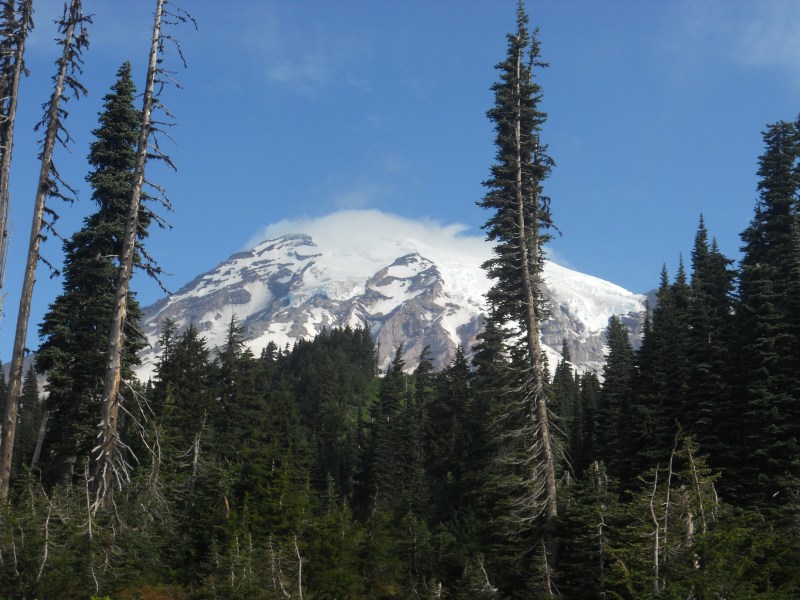
sea dog mountain man, then read on, and I’ll tell a tale or two.
Related: Hiking To An Overnight Camp
First, a few things for you to know…

Mt. Rainier is 14,411 feet above sea level at its highest point, but boasts an impressive 13,210 feet of prominence. If that means nothing to you, it should. It is the most glaciated peak found anywhere in the continental United States, and is frequently used as a training ground for those headed for Himalayan ascents.
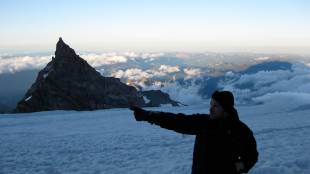
Many who climb the mountain do so with professional guides. The summit success rate of these groups is around 60%; teams or solo climbers have a success rate of well under 50%. Did we have a guide? No. Did we stand on the summit, whiskey in hand? Hell yes we did.
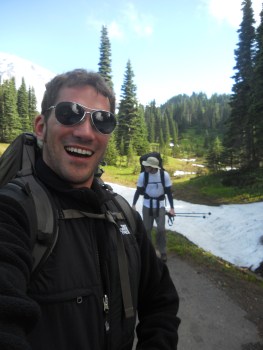
Anyway, rather than give a step-by-step description of the climb (just light your thighs on fire to imagine how most of it feels), instead let me simply share a few specific memories from my climb; moments and sensations that remain fixed in my mind even so long after the lactic acid has receded and the feeling has returned to my extremities.
The Moment of Regret
Only once, in all my alpine wanderings and ascents, only one time ever have I wished I were somewhere else. And of course that moment came on this sumbitch. The team had just rested for a while near Muir Hut, having just ascended the wretched, endless snowfield below. We set out again toward the Ingraham Flats glacier where we’d make camp (“sleep” would last from about 8 PM, thanks to how long it took us to boil then purify water, to 1 AM, when we set out for the summit), but were waylaid on a thin stretch of trail by a slower-moving group ahead. The sun was behind the mountain; the wind was everywhere. My legs ached, my fingers and toes throbbed. We were all hungry, thirsty, tired, and freezing.
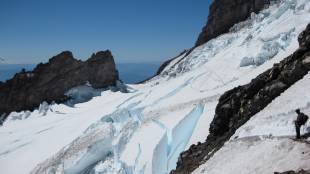
And there was nothing to do but squat there in the snow, wait on that thin band of trail we knew was free of crevasses (you don’t go stomping around someone to pick up speed on Rainier, see?) and I looked around, beauty be damned, and thought: “This is goddamned miserable. I don’t want to be here. I really… don’t.”
But I thought something else, too… I thought (and I paraphrase, but this is close): “I’ll bet within a few hours of being down off the climb tomorrow, I’ll laugh at myself as we all start to talk about the next mountain.” And that’s exactly what happened, stunning soreness and fatigue be damned.
The Star Field
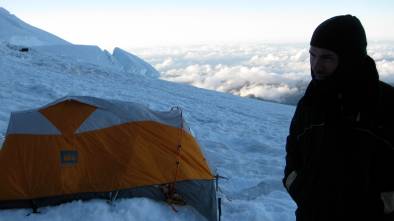
Upon awaking at the crack of around 1 AM, or whenever Chris Coleman’s alarm went off (Mr. Coleman and I shared one tent, the brothers Ryan and Kyle Ariano were in their own shelter a few feet away), I awoke feeling warm and chipper and alert. Or make that cold and ornery and confused. Sleeping more than two miles up on a slab of snow and ice has that effect on the best of us, it turns out. Anyway, groggy and sore and generally as dyspeptic as I was, when I stepped out of the tent after pulling on my snow gear, boots, and crampons, I was all at once awestruck by a scene that stirs me still to picture:
It looked as though either stars had fallen from the firmament and come to rest upon Mt. Rainier, or else stars were rising from the very mountain itself, drifting from snow to sky.
It was a clear night, and spangled with stars. The moon had not risen. But several climbing teams had risen a bit before us, and were already making their way up the vaunted, hated Disappointment Cleaver, working ever so slowly but steadily toward the summit. As it happened, the glow of those dozen or so headlamps, perhaps a half mile away and above my camp, put out just the same perceived luminous power as the stars above. Thus it truly looked as though stars were rising up the darkened mountain, and each time a climber crested the ridge, his star briefly hung in the sky.
Standing On the Summit
I’ve been on my share of summits. I’m no advanced, expert climber, but I’ve been up Mt. Whitney four times, done Southern California’s Baldy and San Gorgonio plenty, and I’ve topped the Grand Teton. Each and every summit experience has been giddy and exciting, with photo ops, whiskey nips, and lots of backslapping. Rainier is different. For starters, the “summit” is a massive caldera. You crest what seems the highest point only to find that it’s a ridge, and you have to go down, across a massive flat crater, and then up again to reach the mountain’s true high point, Columbia Crest.
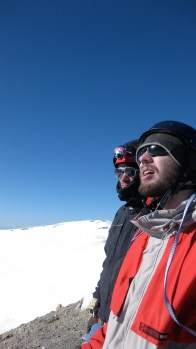
Exhausted though we were, there was no way the four of us were going to almost reach the true summit. So we crested the ridge, dropped as much gear as possible in the middle of the caldera, and trudged to the top. There we mugged for a few photos, took a milliliter or two from our nips in forced celebration, then began the slow… long… trip… down.
I remember looking down from the caldera crest at our distant campsite, spotting miniature orange dots that were our tents, and thinking how that was less than half the distance we had to cover before we could rest.
It was the least energetic summit experience of my life, but it many ways it was one of the best: tired and pissed off as we all were, each of us was aware of the accomplishment. But more importantly, none of us lost his sense of humor, and as anyone who does much climbing knows, it’s pretty hilarious to be miserable.
The Morning After
After a night of deep sleep brought on by the climb (and maybe beer), the team and I limped out to brunch at some Seattle-area restaurant, I couldn’t tell you which. Admittedly, we all looked like hell, which prompted our waiter to ask if we had had a rough night. We told him no, the night was fine, but the previous days spent summiting Rainier had been rather rough. He was unabashedly impressed, having never tried his hand at mountaineering himself. He inquired if we had used a guide service, and I reported that we had not.
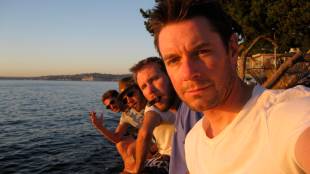
The waiter walked off. A few minutes later, the bar tender walked over. He placed four whiskey drinks in front of us, saying: “Heard you boys made the summit. These are on us.”
Now, I didn’t ask… but I’d bet a dollar or two that guy had done some climbing.



